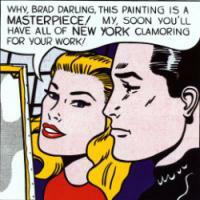Culture
Vatican Searching for Next Raphael. Or Roy Lichtenstein?

The Catholic Church used to be Western Civ's pre-eminent patron of art and architecture. But the past few hundred years have seen the Vatican slowly transition from commissioner to collector, safeguarding the long and luminous tradition of Church art. Tantalizing signs of change are looming, however. Newsweek is reporting on the Vatican's recent plans to reach out to the modern art world and reignite the dialogue between Church and artists: "This fall, the Holy See hopes to revive its cultural side by searching for artists willing to create new interpretations of tired spiritual art. The Vatican campaign is nothing short of a genius hunt for a modern-day Michelangelo or Raphael. ‘We have made great progress with innovative church designs by top architects,’ says Monsignor Gianfranco Ravasi, who heads the Pontifical Council for Culture, which is spearheading the project. "Now we need artwork of the level we inspired centuries ago.""
Part of the plan might be to encourage Medici-style sugar daddies—faithful Catholics with deep pockets willing to invest in new, innovative works of Church art. Catholics continue to produce great art independently, but constraints of time and cash make large-scale projects like the Sistine Chapel ceiling prohibitively costly without the support of the Church. The danger for current clergy and churchgoers is to mourn the passing of past greatness without investing hope and resources in the future.
It's worth remembering that in his own time an artist like Michelangelo was fiercely "modern," even provocative, often tussling with Pope Julius II over the form and content of his work. Who wouldn't love to hear a Requiem Mass composed by Ennio Morricone? Or visit a church designed by the next generation's Gaudi? Does the Church have the wisdom and courage to seek out art that synthesizes “the integrity of the church's beliefs” with “the shock of the new?” We’ll see. “I think the project is a superb idea,” said Renzo Piano, a long-time promoter of avant-garde art within the Church, “but they have to give freedom or the project will never work.”
By AT 09.22.08 01:21PM Not Rated
KING-WAI FUNG—good point, art schools today largely teach what I call “phony art.” I’ve always believed that the artist’s duty is to authentically seek and express the beauty of God’s creation, to celebrate it, not to pervert or denounce.
Michelangelo may have been fiercely “modern,” but he was still working within the confines of Christendom, his art’s purpose was a legitimate form of prayer. Today’s “fiercely modern” artists make art for art’s sake, founded on a secular humanist philosophy, and, as stated above, seek to shock the viewer just to get noticed.
If the Vatican is going to re-ignite the tradition of Church art, they must first seek masters who are Christians.
By AT 09.22.08 09:10PM Not Rated
For Michelangelo, art certainly was a form of prayer. It continues to be a form of prayer for many artists working today, even if their art doesn’t resemble Michelangelo’s. A painter like Piet Mondrian would use simple colors combined in abstract designs to create an impression of harmony and balance. It was Mondrian’s way of expressing, in a style that had the “shock of the new”, the underlying unity and beauty of God’s creation—a prayer, in other words, even if a quiet, contemplative, and highly personal prayer.
Perhaps the problem is that much contemporary art has made expression of Self the highest good, and this has given rise to much of the ‘phony art’ that I think Chassup is talking about—mindless splatters of paint, ‘provocative’ art that is fundamentally puerile (most any art that involves bodily functions, let’s say), or art that exists only to draw attention to the cleverness of the Artist. But it’s worth remembering that the Renaissance was part of the development of secular humanism, with the philosophy of Neoplatonism and a fascination with the pagan, Greco-Roman ideal of beauty—something that appears in Michelangelo’s art.
Michelangelo was a fervent Catholic, certainly, but he also pushed art forward by making art that challenged the mainstream and abounded with individuality: he even scrawled his signature across the sash of Mary’s robe in his beautiful Pieta, that’s how much he wanted to get noticed for his talent. This is the privilege and the responsibility of an artist—to use one’s talent and genius (which can include creating art of ‘arresting strangeness,’ as Harold Bloom put it) in the service of something higher and more powerful: thus, the Sistine Chapel, Mozart’s Requiem Mass, or the poetry of Gerard Manley Hopkins.
I hope the Vatican will seek out beautiful examples of Catholic art from innovative painters, sculptors, and stained-glass designers who filter their art through the life and lessons of Christ. Christ’s message included paradoxes. Goya and Caravaggio were both hotheaded rebels who got into frequent trouble with the Church, but they produced some of the Church’s most enduring masterpieces. If the Church keeps an open mind, I think some wonderful surprises could be in store for the art-loving faithful in the years ahead.









By King-Wai Fung AT 09.22.08 03:25AM Not Rated
I wonder if the training of today’s artists is not embroiled with assumptions that distract from the real task of the artist (a la JPII’s Letter to Artists). Particularly, I think this exaltation of the “shock of the new” (i.e. the elevation of novelty to the status of beauty) is at odds with the most basic of Christian anthropological principles: that we are uniquely made in the image and likeness of God. In other words the artist doesn’t need to spend his energy trying to out-innovate his peers or be “original” (as he is taught in art school) because he himself is unique and unrepeatable.